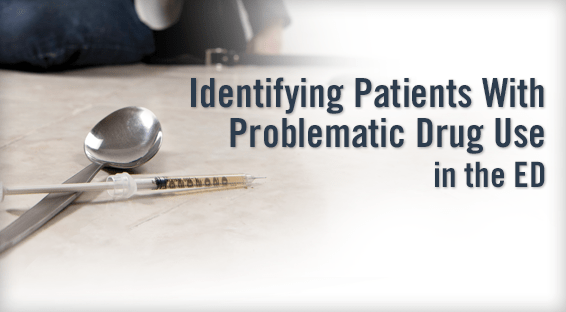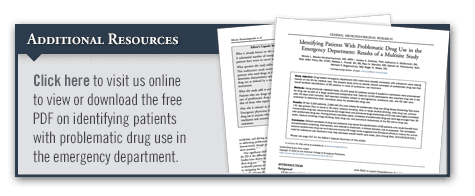According to the Drug Abuse Warning Network, 2.5 million of the 5.1 million drug-related ED visits nationwide in 2011 were directly related to the use of illicit substances, non-medical use of pharmaceuticals, or a combin-ation of the two. In 2008, researchers found that the total annual cost of illicit drug use was about $151.4 billion. Medical care costs alone account for $5.4 billion of that total annual cost, not including costs for substance use treatment. “Studies have shown that drug users are more likely to use the ED for their medical care and are more likely to require hospitalization than those who don’t use drugs,” says Wendy L. Macias-Konstantopoulos, MD, MPH.
The American College of Emergency Physicians and other organizations have recommended using screening, brief intervention, and referral to treatment (SBIRT) in the ED for problematic alcohol use. Many studies have demonstrated the effectiveness of SBIRT for alcohol use, but its effectiveness in addressing problematic drug use may also be promising, especially if implemented in ED settings. The challenge with addressing drug use disorders in the ED is that these problems are often difficult to detect, says Dr. Macias-Konstantopoulos. “Patients tend to deny or underreport illicit drug use,” she says. “If we can improve our ability to identify patients with drug use problems, we have an opportunity to mitigate the subsequent health effects.”
New Data
In a study published in Annals of Emergency Medicine, Dr. Macias-Konstantopoulos and colleagues sought to identify characteristics that were associated with problematic drug use in ED patients who reported drug use during the past month. Using previously validated tests, investigators prescreened more than 15,000 adult ED patients for drug use, of whom 3,240 participants reported using drugs in the past 30 days.
“A key finding from our study was that about 64% of patients who reported using drugs in the previous month met criteria for problematic drug use,” says Dr. Macias-Konstantopoulos. “Primary non-marijuana drug users had an almost 15 times higher odds of meeting criteria for problematic drug use than primary marijuana users. These patients also tended to require more medical resources in the ED.” More than 90% of ED patients reporting any drug other than marijuana as their primary drug of use met the criteria for problematic drug use. Non-marijuana drug users who were identified as problem drug users were more likely to be 30 or older and have a resource-intense ED triage level.
Among patients who reported using marijuana as their primary drug, more than 46% met the criteria for having a drug problem. “This is an important finding to highlight because marijuana use is often considered less dangerous than other illicit drug use,” Dr. Macias-Konstantopoulos says. According to the study, a subgroup of marijuana users was at higher risk for problematic drug use, including age younger than 30, smoking tobacco, binge drinking, using drugs daily, and reporting that their ED visit was related to their drug use (Table).
A Helpful Decision Rule
The study team also proposed a brief clinical decision rule that uses clinical correlates of drug use problems to help identify ED patients who may benefit from SBIRT. Dr. Macias-Konstantopoulos and colleagues derived a simple rule using “primary drug used” and “perceived ED visit relatedness to drug use” as the sole screening questions, each being the single decision-making branch point for non-marijuana and marijuana users, respectively (Figure).
According to the study, the proposed brief decision rule is less cumbersome to implement than one that includes multiple questions about specific substance use behaviors. It is also less dependent on the accuracy of self-reported substance use behaviors and accounts for the high probability of problematic drug use among individuals who primarily use a drug other than marijuana. Furthermore, it identifies a subgroup of patients within the lower-risk primary marijuana user group that has a higher likelihood of problematic drug use.
Seizing Opportunities
“Substance use-related health events that lead to ED visits are opportunities for clinicians to use ‘teachable moments’ and deliver brief but meaningful interventions,” Dr. Macias-Konstantopoulos says. “Identifying patients with problematic drug use is an important first step. We can have a positive impact by interrupting problematic drug use and improving health outcomes in these patients. At the same time, we can also potentially decrease overall substance use-related healthcare costs in the future.”



